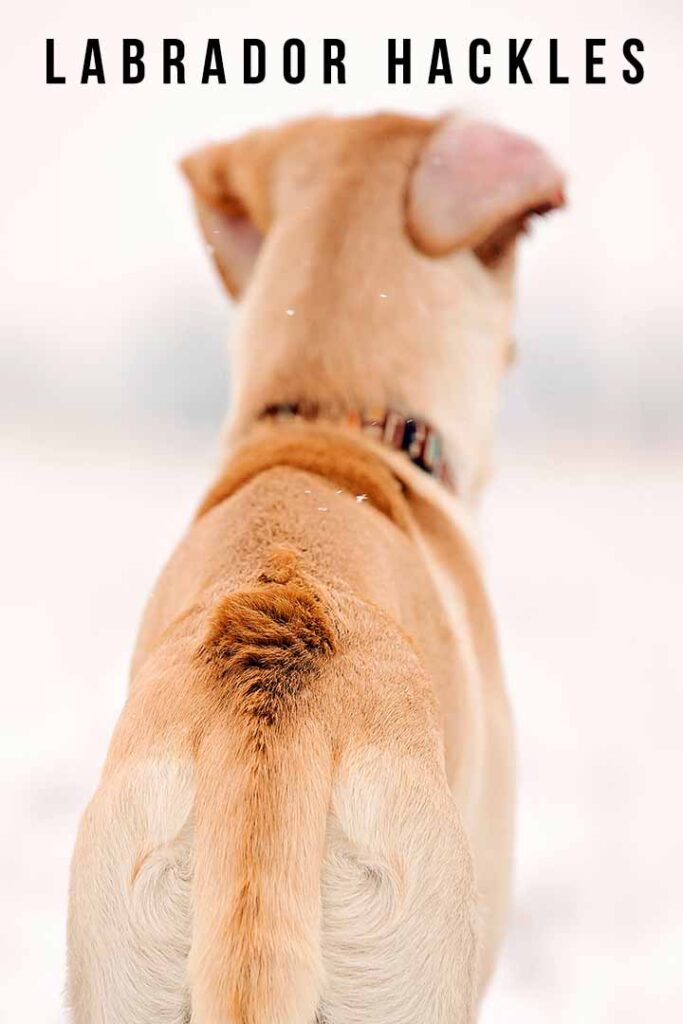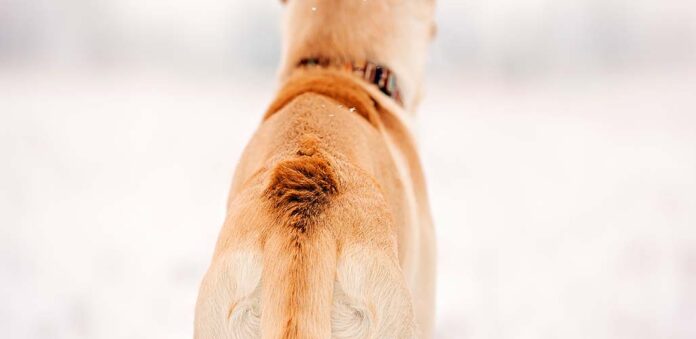In this handy guide to canine body language, we explain how Labrador hackles reveal information about their emotional state, and all the things it can mean when they have their hackles raised.
- What are Labrador hackles?
- How do hackles work?
- What do raised hackles mean?
- How to interpret hackles on a dog
- Stressed dog body language
- Signs of a confident dog
Labrador hackles are hairs down the nape of their neck and center of their back which stand up when they are in a state of emotional arousal. Contrary to a popular misconception, it doesn’t always mean they are feeling angry or afraid. To interpret what it does mean, you need to look at the context and other clues in their body language too.
Labradors’ hackles are just one of the ways they communicate with each other. To human observers, raised hackles can be intimidating. But they can be a sign of happiness too! And since they share important information about your dog’s emotional state, it’s important to learn to understand them correctly.
What are Labrador hackles?
Labs’ hackles are a region of fur running from the nape of their neck down the center of their back. When they are in a state of emotional arousal, the guard hairs in the hackles stand on end, which is called piloerection. The size and shape of the hackle region varies between individual dogs. Some dogs’ hackles are like a ruff or mane across their shoulders and the back of their neck. And some dogs’ hackles run down the center of their back like a mohican. Some owners even report quite unusual hackle formations, like a small circle at the base of their tail, and nothing else!
The appearance of a Lab’s raised hackles also depends upon the length and texture of their coat. English type Labs (also known as show or bench type Labs) are more likely to have longer, denser, coarser coats. So their hackles can look very dramatic! American type Labs (also known as working or field type) tend to have shorter, thinner hair, which is still obviously erect when their hackles are up, but the effect is less dramatic.
How do hackles work?
The hairs in the hackles are raised individually, by tiny arrector pili muscles at the base of each follicle. Dogs can’t exercise any conscious control over it happening – a bit like goosebumps in people. It is triggered subconsciously when they enter a heightened emotional state. Their hackles go down again when the emotional ‘rush’ subsides. This is sometimes accompanied by a physical release, like shaking or doing a short sprint.
What do raised hackles mean?
For lots of us, raised hackles are closely associated in our mind’s eye with aggressive behaviors – holding their body weight low and forwards, and growling, barking or snapping. And it’s true that a worried, angry, or acutely upset dog might have their hackles up. But raised hackles aren’t exclusive to these situations.

In fact, dogs’ hackles might go up when they’re in any kind of heightened emotional state. This includes:
- Excitement. Such as during a great game.
- Anticipation. For example when the doorbell rings.
- Surprise. If someone or another dog appears suddenly from around a corner.
- Fear. If they feel threatened by something known or unknown.
- Uncertainty. Such as when meeting an unfamiliar dog for the first time, and not knowing if they’re friendly.
- Discomfort. For example at having their space invaded by an unfamiliar dog or impertinent puppy.
Sometimes Labradors’ hackles also go up during social interactions with unrelated, unfamiliar dogs, as part of establishing social dominance.
How to interpret hackles on a dog
So, all raised hackles mean for sure is that your Lab is experiencing some Big Emotions. And it’s up to you to work out what kind of emotions, and what (if anything) you ought to do about it. Here’s how.
Look at the context
Over in our Labrador Forum, many of our members have compared notes on the things which get their Labs’ hackles up. The triggers vary from dog to dog, but one thing everyone agrees on is that context is key for understanding what kind of emotional state their dog’s hackles are expressing. For example a Lab whose hackles go up during a game of chase is likely to be expressing excitement. On the other hand if their hackles go up when another walker appears suddenly, it’s more likely they’re surprised.
Quite a lot of our readers and forum contributors report that their dogs’ hackles go up when they meet another dog. Labradors often have high social confidence around other dogs, so it could be excitement again. But it could also be a sign of uncertainty or anxiety because they don’t know if the new dog is friendly yet. Or irritation, if they feel the other dog was a bit too impertinent about invading their space to say hello. They could simply be alert to unknown possibilities! To tell these possibilities apart, you need to look at the rest of their body language next.
Stressed dog body language
Dogs who are anxious or stressed may
- stand stiffly
- flatten their ears back
- avoid eye contact
- hold their tail very rigidly, or tuck it between their legs
- yawn
- lick their lips
- try to back away.
When Labrador hackles are paired with one or more of these behaviors, you should act immediately to exit the situation. If it’s been triggered by meeting someone or their dog, offer a brisk ‘great to see you, enjoy your day’, and move away with your Lab. If it’s not clear what’s triggered it, move out of the environment altogether. Don’t force your dog to stay put and face what’s upsetting them, no matter how objectively harmless it is to you. This could cause their behavior to escalate into barking, lunging or biting. Our guide to managing reactive behavior can help you plan your next steps to overcome their worries – there’s a link at the bottom of this article!
Signs of a confident dog
A confident dog has a relaxed posture and facial expression. Their tail might be wagging, and they might perform a play bow to invite their new acquaintance to play. If your dog is happy and confident, remember to check that the other dog is too, and ask their owner’s blessing before releasing your dog to play with them.
Make notes
Finally, keep track of what triggers cause your dog to raise their hackles. If you still use a paper diary, jot notes in there. Or you can keep a note in the back of your training log, or even a piece of paper tucked into their vaccination record. Anywhere you can easily find it and refer to it. This will help you keep track of patterns in their reactions.
If your Labrador is generally confident, but raises their hackles when they’re playful or excited, that’s great. Bear in mind that a big dog with raised hackles can be an intimidating or alarming site for other people though. You’ll need to be respectful of people who don’t want to be approached by your excited dog (this is true whether they raise their hackles or not!) and patient about reassuring people that it’s not a sign that they’re aggressive.
Labrador hackles summary
Labradors’ hackles are a region of guard hairs on their shoulders and back which stand on end when they are in a state of high emotional arousal. It’s not something they have conscious control over, so learning to interpret the triggers is a good way to understand how your Lab is really feeling about something.
For more insight into the inner world of your Labrador, you’ll enjoy these resources too:
- Aggressive And Reactive Behavior in Labradors
- Alpha Dog – The Facts About Dog Dominance And Pack Leaders
- Does My Labrador Have Separation Anxiety?
- Why Do Dogs Bark? How To Make Sense Of Your Dog’s Barking
- Why Do Dogs Run Away And How To Stop Them
- How To Cope With A Naughty Labrador
- Labrador Forum
The Labrador Site Founder
Pippa Mattinson is the best selling author of The Happy Puppy Handbook, the Labrador Handbook, Choosing The Perfect Puppy, and Total Recall.
She is also the founder of the Gundog Trust and the Dogsnet Online Training Program
Pippa's online training courses were launched in 2019 and you can find the latest course dates on the Dogsnet website



















